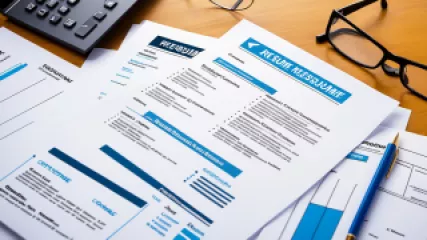Effective Resume Writing Assistance for Career Counseling
Welcome to our comprehensive guide on effective resume writing assistance for career counseling. Crafting a professional and compelling resume is an essential step in securing job opportunities. Whether you are a recent graduate entering the job market or a seasoned professional looking for a career change, a well-written resume can make all the difference. In this guide, we will provide you with step-by-step instructions, practical tips, and expert advice to help you create a standout resume that showcases your skills and experiences.
1. Understand the Purpose of a Resume
Before diving into the intricacies of resume writing, it is crucial to understand the purpose of this document. A resume serves as your personal marketing tool, highlighting your qualifications, achievements, and suitability for a specific job position. It should demonstrate your unique value proposition and convince employers to invite you for an interview. Keep in mind that a resume is not a comprehensive biography; rather, it is a concise summary of your relevant professional experiences.
2. Choose the Right Resume Format
The next step in effective resume writing is selecting the appropriate format. There are three main types of resume formats:
- Reverse Chronological: This format focuses on your work history and experience, listing your most recent position first.
- Functional: The functional format emphasizes your skills and abilities, rather than your chronological work history. It is useful for individuals with gaps in employment or those changing careers.
- Combination: As the name suggests, the combination format combines elements of both the reverse chronological and functional formats. It allows you to showcase your skills while also providing a chronological overview of your work history.
Consider your individual circumstances and choose the format that best highlights your qualifications and aligns with the expectations of your target industry.
3. Gather Relevant Information
Before starting the actual writing process, gather all the necessary information that will be included in your resume. This includes:
- Your contact information (name, phone number, email address, and LinkedIn profile).
- Educational background, including degrees, certifications, and relevant coursework.
- Work experience, including job titles, company names, dates of employment, and key responsibilities.
- Skills relevant to the job you are applying for, including technical skills, languages, and certifications.
- Awards, achievements, and notable projects that demonstrate your capabilities.
- References or testimonials from previous employers or colleagues, if available.
Gathering this information beforehand will streamline the resume writing process and ensure that you do not miss any important details.
4. Craft a Compelling Summary or Objective Statement
The opening section of your resume is crucial as it sets the tone for the rest of the document. Depending on your level of experience and the industry norms, you can include either a summary statement or an objective statement.
A summary statement provides a concise overview of your qualifications, highlighting your most relevant skills and experiences. On the other hand, an objective statement focuses on your career goals and the specific role you are seeking. Tailor this section to match the requirements of the job you are applying for and grab the attention of potential employers.
5. Highlight Your Professional Experience
One of the most critical sections of your resume is the professional experience section. Here, you should provide a detailed account of your work history, focusing on your accomplishments and responsibilities in each role.
Start with your most recent position and work backward chronologically. Include the following information for each job:
- Job title and company name
- Dates of employment
- Main responsibilities and duties
- Key achievements and results
Quantify your accomplishments whenever possible by using specific numbers, percentages, or other measurable outcomes. This will help employers gauge the impact you had in previous roles.
6. Showcase Your Skills
In addition to your work experience, it is essential to highlight your relevant skills on your resume. Create a separate section where you can list both hard and soft skills that are directly applicable to the job you are targeting.
Hard skills are specific technical abilities that you have acquired through education or experience. They may include programming languages, software proficiency, data analysis, or any other specialized skills relevant to your field.
Soft skills, on the other hand, are personal attributes that enable you to work effectively with others. These may include communication skills, leadership abilities, problem-solving capabilities, or adaptability. Be sure to provide concrete examples or experiences that demonstrate your proficiency in these areas.
7. Include Relevant Education and Certifications
Educational qualifications play a significant role in many industries. Include your educational background, including degrees, certifications, and relevant coursework.
If you are a recent graduate or have limited work experience, place emphasis on your academic achievements and any relevant projects or internships you have completed. Highlight any honors or awards you received during your studies.
8. Optimize Your Resume for Applicant Tracking Systems (ATS)
Many companies use applicant tracking systems (ATS) to streamline the hiring process. These systems scan resumes for specific keywords and phrases to identify qualified candidates. To increase your chances of getting past the initial screening, optimize your resume for ATS:
- Use relevant keywords throughout your resume that align with the job description.
- Format your resume using simple, standard fonts and avoid excessive formatting or graphics.
- Include a skills section tailored to the desired qualifications outlined in the job posting.
- Save your resume in a compatible file format (such as PDF) to ensure it is readable by the ATS.
9. Proofread and Edit
Before submitting your resume, thoroughly proofread and edit it to ensure accuracy and professionalism. Look for any spelling or grammatical errors, inconsistencies in formatting, or missing information.
Consider asking a trusted friend, family member, or career counselor to review your resume and provide constructive feedback. Fresh eyes can often catch mistakes or offer valuable suggestions for improvement.
10. Seek Professional Resume Writing Assistance
If you feel overwhelmed or unsure about the resume writing process, don't hesitate to seek professional assistance. Online career mentorship platforms and employment counseling services offer specialized resume writing assistance. They can provide personalized guidance and help you create a compelling resume tailored to your specific career goals.
Additionally, consider seeking work-life balance coaching or career planning resources to gain a deeper understanding of your strengths, values, and interests. These services can assist you in finding your passion and aligning it with your career choices.
In conclusion, effective resume writing is an essential skill for career advancement. By following the steps outlined in this guide, you can create a well-crafted resume that highlights your qualifications and increases your chances of landing the job of your dreams. Remember to tailor your resume to each position, showcase your achievements, and seek professional assistance when needed. Good luck on your career journey!






